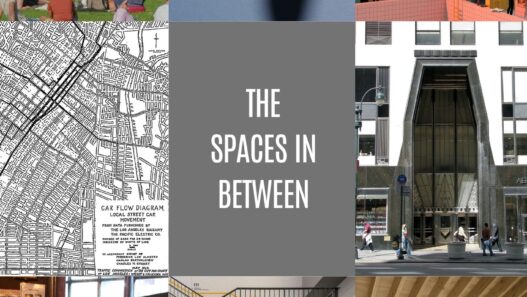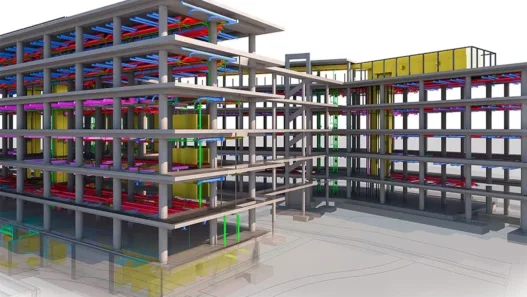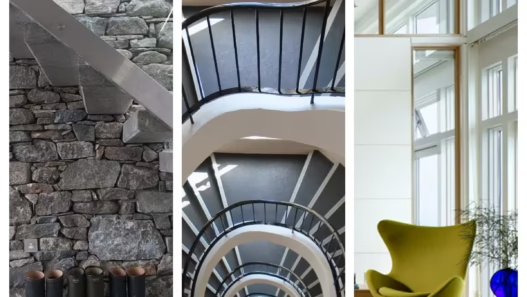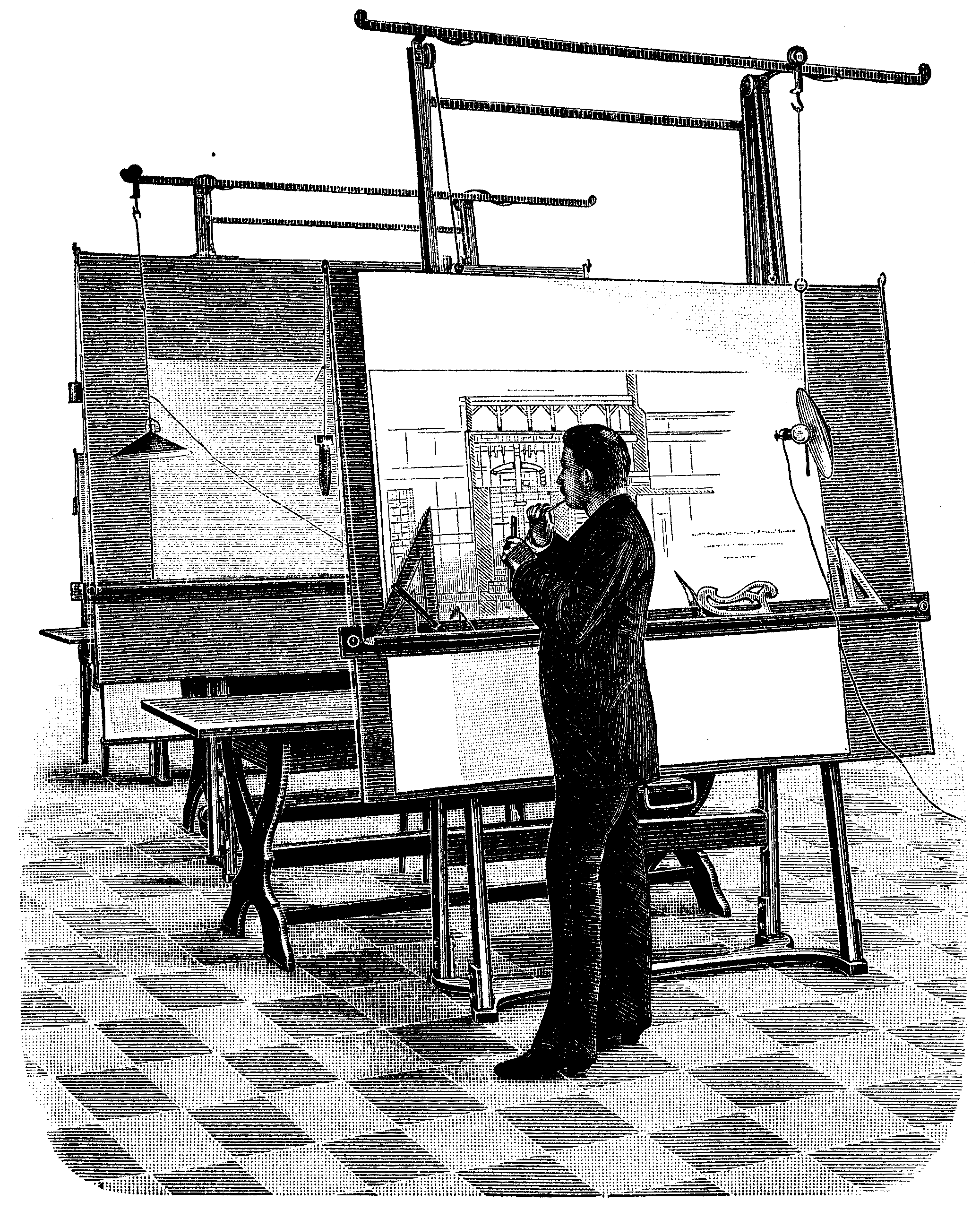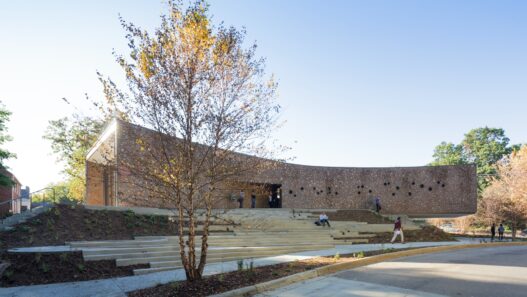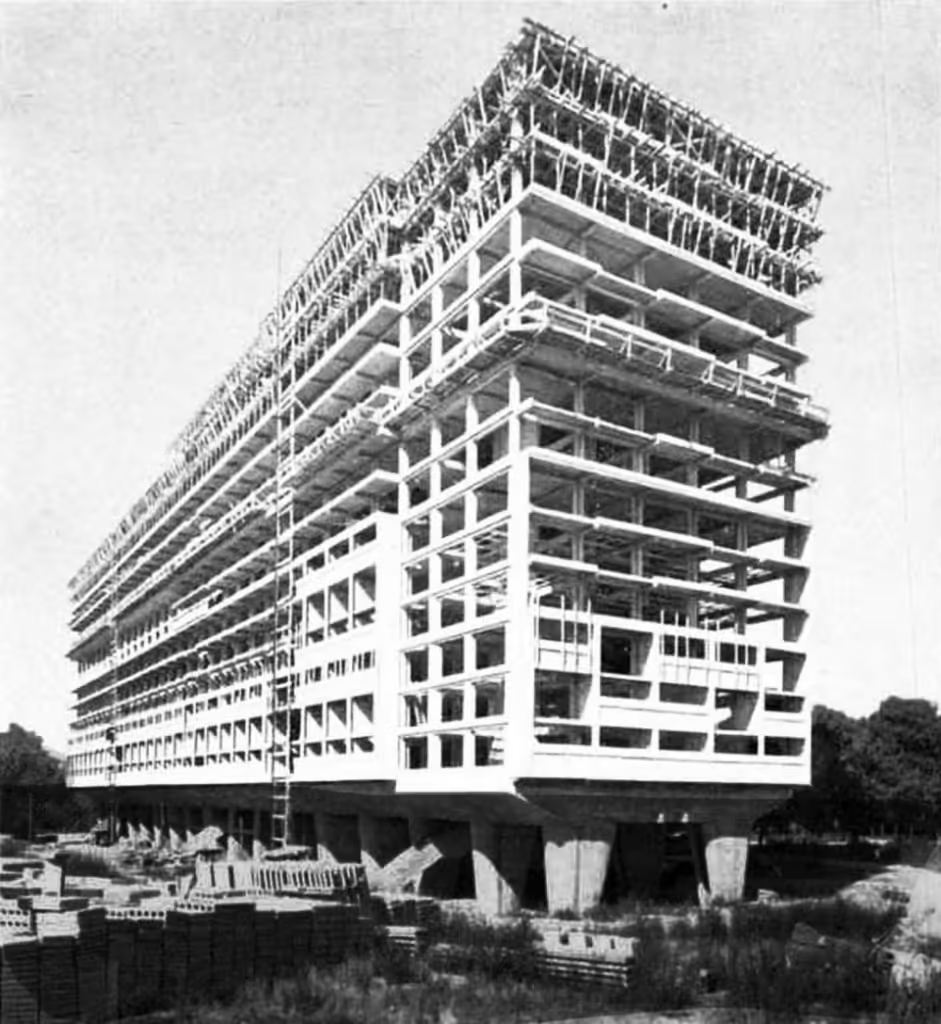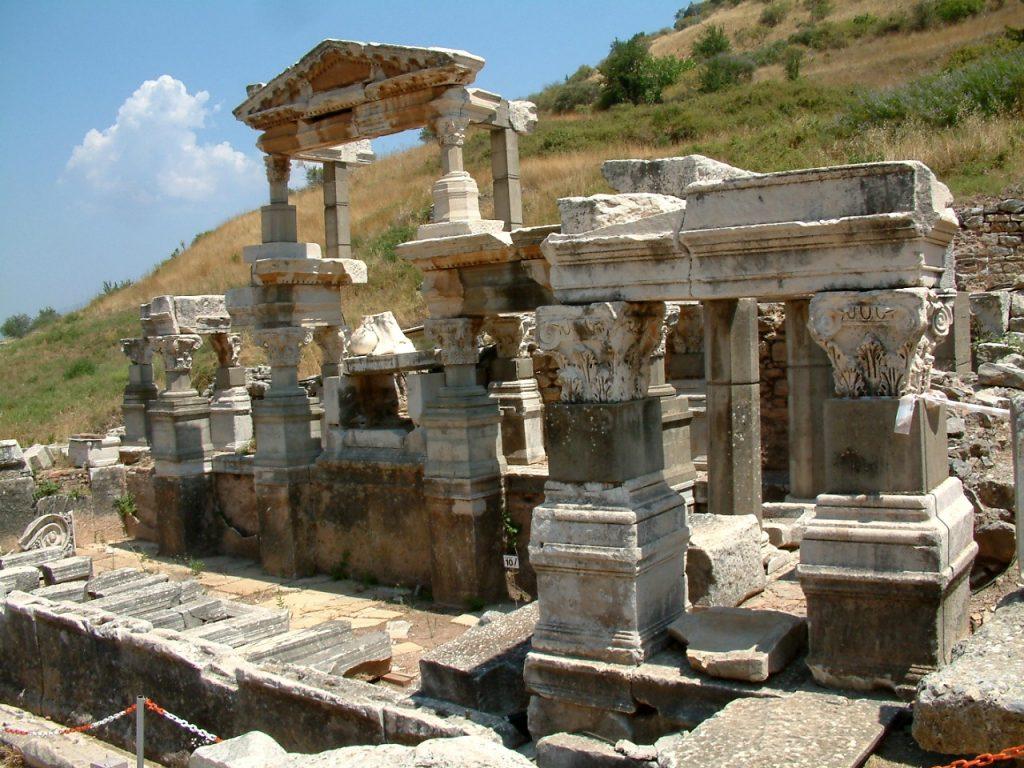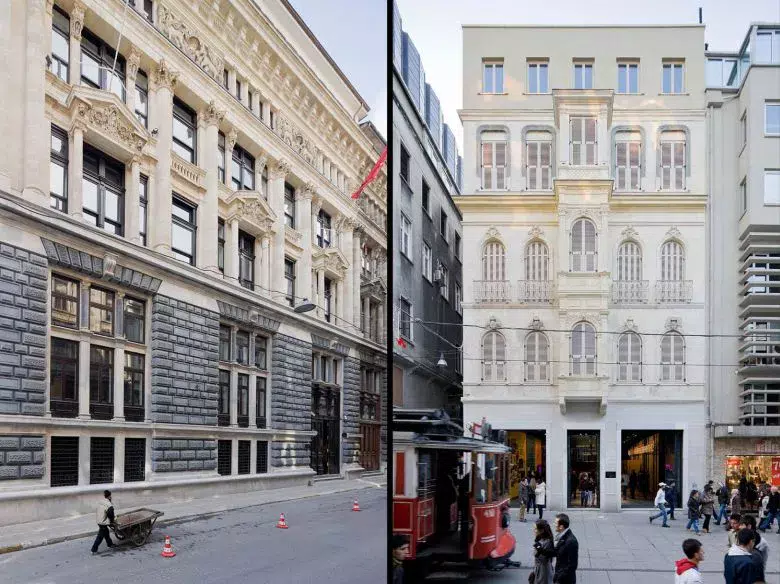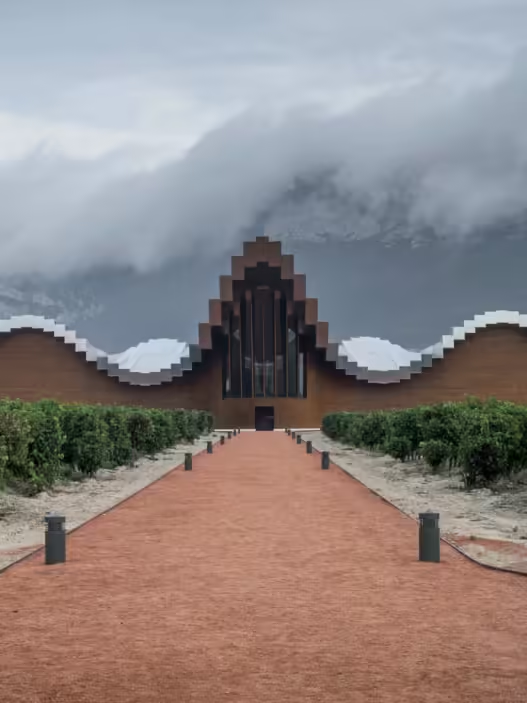Most of the houses built in Turkey may have a similar style and structure. Unité d’Habitation tells a different story. Designed by Le Corbusier, this building is an important example of modernist architecture. To share an interesting statistic, the Unité d’Habitation has been in service since its completion in 1952 and is still considered not just a housing unit but a symbol of a lifestyle.
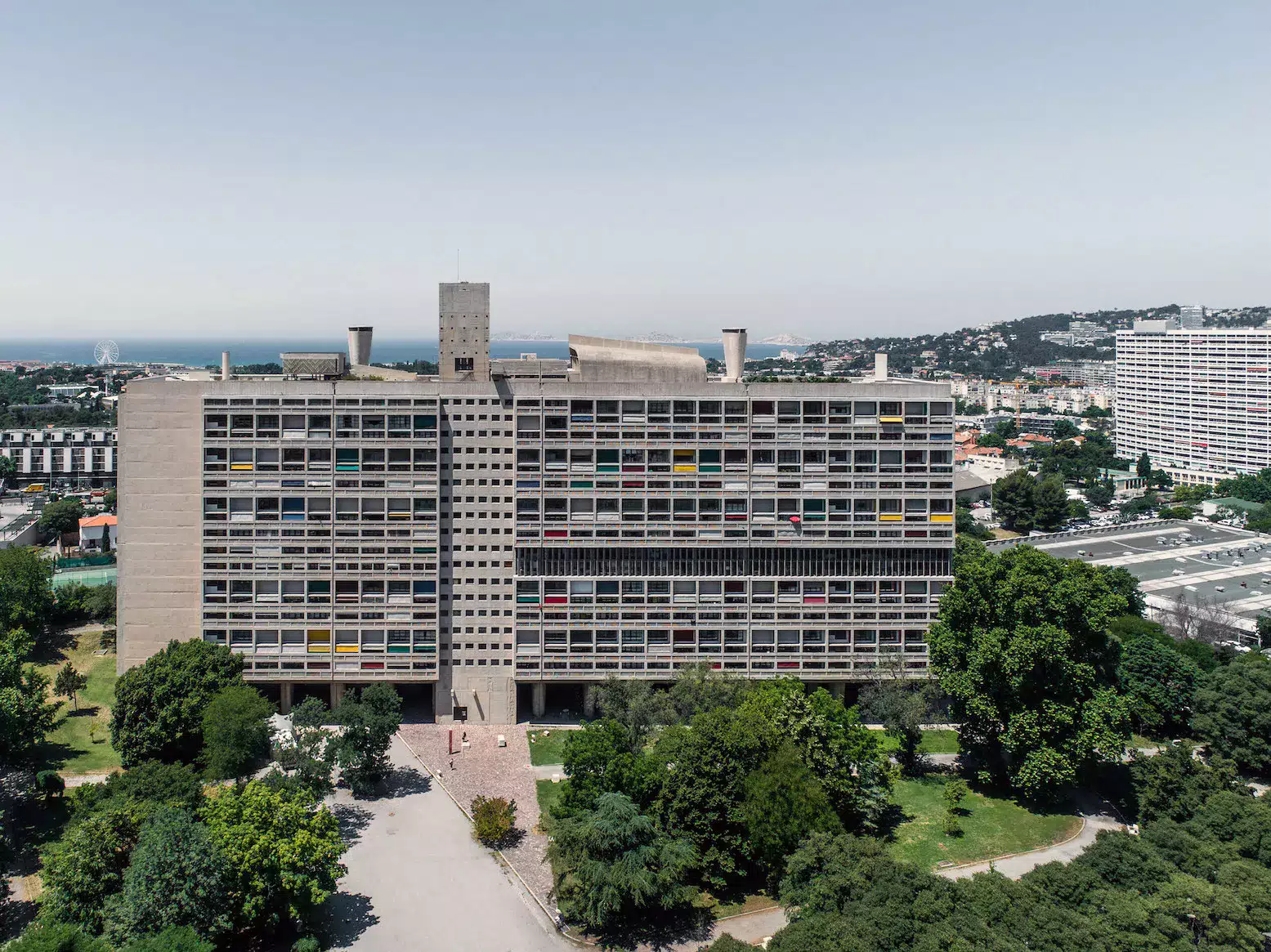
The architectural design of this impressive building is synonymous with concepts such as Le Corbusier design, concrete structures and brutalist architecture. At the same time, Unité d’Habitation, a revolution in public housing, is also recognized as a building that shaped the evolution of modern architecture.
- Architect and Style: Designed by Le Corbusier, Unité d’Habitation is an important example of modernist and functionalist architecture.
- Year and Place of Construction: Built between 1947 and 1952 in Marseille, France.
- Multifunctional Building: It functions not only as a residential complex, but also as a space for community living and social interaction.
- Use of Industrial Materials: Under the leadership of Le Corbusier, the use of industrial materials is at the forefront.
- Open Plan Layout: Unité d’Habitation is characterized by its open-plan layout, making it ideal for modern living.
- Vertical Gardens and Communal Areas: The building encourages social interaction with its vertical gardens, outdoor terraces and common areas.
- Designed for Community: Designed as a living space where people can come together and form a community.
- The Evolution of Modern Architecture: Unité d’Habitation is an important example of the evolution of modern architecture and how it has shaped the way people live.
- Le Corbusier’s Legacy: One of the most important works reflecting Le Corbusier’s architectural approach and influence.
- Cultural and Historical Significance: The Unité d’Habitation is not only architecturally significant, but also culturally and historically significant, a symbol of the modern way of life.
Let’s take a closer look at Unité d’Habitation, one of the leading examples of modernist architecture.
Le Corbusier and Modernist Architecture
Le Corbusier, one of the prominent names in the field of modern architecture, is an architect who has made a great impact with his architectural designs. In this section, we will provide detailed information about the innovations Le Corbusier brought to modernist architecture and the importance of Unité d’Habitation in architectural history.
Le Corbusier is considered one of the pioneers of the modernist architectural movement. Functionality, minimalist approach and geometric forms are at the forefront of his designs. Le Corbusier’s designs are considered one of the turning points in architectural history and inspire modern architecture even today.



Le Corbusier’s Innovations to Modernist Architecture
- Le Corbusier emphasized the use of concrete in his architectural designs. Concrete structures became a frequently preferred material in modern architecture and Le Corbusier’s approach had a great influence on other architects.
- Le Corbusier brought a new perspective to housing projects. In projects such as Unité d’Habitation, he thought of collective housing and individual housing units together and presented a new residential lifestyle.
- Geometric forms and a minimalist approach are the main characteristics of Le Corbusier’s designs. This approach reflects an effort to strike a balance between aesthetics and functionality in modern architecture.
The Place of Unité d’Habitation in the History of Architecture
Unité d’Habitation is one of Le Corbusier’s most famous buildings and has an important place in the history of architecture. This building is one of the representatives of modernist architecture and is considered a turning point in modern housing design.
Unité d’Habitation is a design that brings a new understanding to public housing projects and approaches housing units from a different perspective. The housing revolution initiated by Le Corbusier with Unité d’Habitation is still influential today and inspires modern housing projects.
Le Corbusier’s innovations in modernist architecture and the Unité d’Habitation’s place in architectural history are of great importance in the world of architecture. These designs are considered as a legacy for future generations and occupy an important place in the history of modern architecture.
| Le Corbusier and Modernist Architecture | Importance in Architectural History |
|---|---|
| Le Corbusier, one of the pioneers of the modernist architectural movement, left his mark on the history of modern architecture with his designs. | Le Corbusier’s designs brought a new perspective to modern architecture and became a turning point in architectural history. |
| Le Corbusier’s innovative approach, minimalist designs and geometric forms emphasized the importance of stylistic elements in modern architecture. | His buildings such as Unité d’Habitation are important examples of modern residential design and are part of the architectural heritage. |
| Le Corbusier’s buildings such as Unité d’Habitation contributed to the widespread use of concrete structures in modern architecture. | Unité d’Habitation is at the forefront of architectural history for bringing a new perspective to mass housing projects and is a valuable piece of architectural heritage. |
Design of Unité d’Habitation
In this episode, we will focus on the design of the Unité d’Habitation. You can learn more about Le Corbusier’s innovative and modern approach to modern architecture. Unité d’Habitation is one of Le Corbusier’s revolutionary projects in the field of public housing.
Unité d’Habitation is a building that reflects the basic principles of modern architecture. In this design, Le Corbusier combined functionality and aesthetics to improve people’s quality of life. Combining high concrete structures and modernist architecture, this project occupies an important place in the history of architecture.
One of the most striking features of the design is the new approach that its architectural form brings to residential units. Unité d’Habitation combines dwellings into blocks to form residential units. These units are designed to make the most of daylight, each with large balconies.


Concrete is at the forefront of the materials used in Le Corbusier’s Unité d’Habitation design. Concrete is a material frequently used in modern architecture due to its high durability and flexibility. In Unité d’Habitation, concrete structures are both a strong feature of the design and part of the architectural aesthetic.
This design is considered one of the most important examples of modern architecture and has cemented its place in the history of architecture. Unité d’Habitation is a building that left its mark on the world of architecture with Le Corbusier’s vision and the innovations he brought to modern architecture.
| Design Features | Description |
|---|---|
| High Concrete Structures | Unité d’Habitation stands out for its high concrete structures. This is a strong feature of the design and one of the basic principles of modern architecture. |
| Residential Units | Unité d’Habitation combines dwellings to create block-shaped housing units. These units are designed with large balconies and spaces that make the most of daylight. |
| Modernist Architecture | Unité d’Habitation is designed with modernist architectural principles. It is a building that combines functionality, aesthetics and innovation. |
Brutalist Architecture and Unité d’Habitation
Unité d’Habitation is an important example of brutalist architecture in the world of architecture. Brutalist architecture represents a rough and natural aesthetic and creates a harmonious unity with concrete structures. Unité d’Habitation is characterized by this style and is designed from a modernist perspective.
Concrete structures are one of the elements that define the identity of Unité d’Habitation. With their strength and durability, these structures have a functionality that goes beyond mere visual impact. When used as both a structural and decorative material, concrete adds strength and character to architecture.
Unité d’Habitation is an example of brutalist architecture meets elegance. This structure, where concrete is shaped with gentleness, creates a different atmosphere in living spaces.
This architectural style is used to emphasize the unique design of the Unité d’Habitation. The exterior, created with concrete structures, showcases the play of lines and volumes, while the interiors provide a comfortable living space. The hardness and naturalness of concrete makes Unité d’Habitation, as a residential unit, a modern and sustainable architectural design.
Housing Unit Designs
Swiss-born French architect Le Corbusier brought a new perspective to modern architecture with his Unité d’Habitation project. This project is shaped by a different approach to the design of housing units. The housing unit designs aim to combine functionality, aesthetics and user comfort.
The dwelling unit designs in Unité d’Habitation consist of buildings lined up side by side. Each building offers a private residential unit and also includes communal spaces. This allows residents to enjoy their private living space and interact in the communal social areas.
Continuously Developed Designs
Le Corbusier continuously improved his housing unit designs. He aimed to maximize the comfort of the inhabitants by giving importance to functionality, ergonomics and details for user needs.
In these designs, architectural details and freedom of thought go hand in hand. Le Corbusier adopted a flexible approach that supports customizing spaces according to the needs of the users. Housing unit designs include spaces that fit the lifestyle of the user and details for individual preferences.
“In housing unit designs, it is important to design spaces to suit people’s lifestyles. Flexibility to the needs of users is an essential element in modern architecture.” – Le Corbusier
Balance of Aesthetics and Functionality
The residential unit designs in Unité d’Habitation strike a balance between aesthetics and functionality. Both the exterior façade designs and the interior arrangements reflect the unique characteristics of modern architecture.
Le Corbusier integrated the characteristic elements of modern architecture such as straight lines, geometric forms and the use of natural light into the housing unit designs. In addition to aesthetic elements, the functionality of the housing units is also prioritized. Practical solutions designed to meet the daily living needs of the users are presented.
Le Corbusier’s housing unit designs are recognized as one of the pioneers of modern architecture. The Unité d’Habitation project is an important milestone in the history of architecture and gave a new vision to housing unit designs.
Interiors at Unité d’Habitation
Le Corbusier’s Unité d’Habitation project is also notable for its interior design. This modernist architectural structure combines functional and aesthetic balance in the interiors.
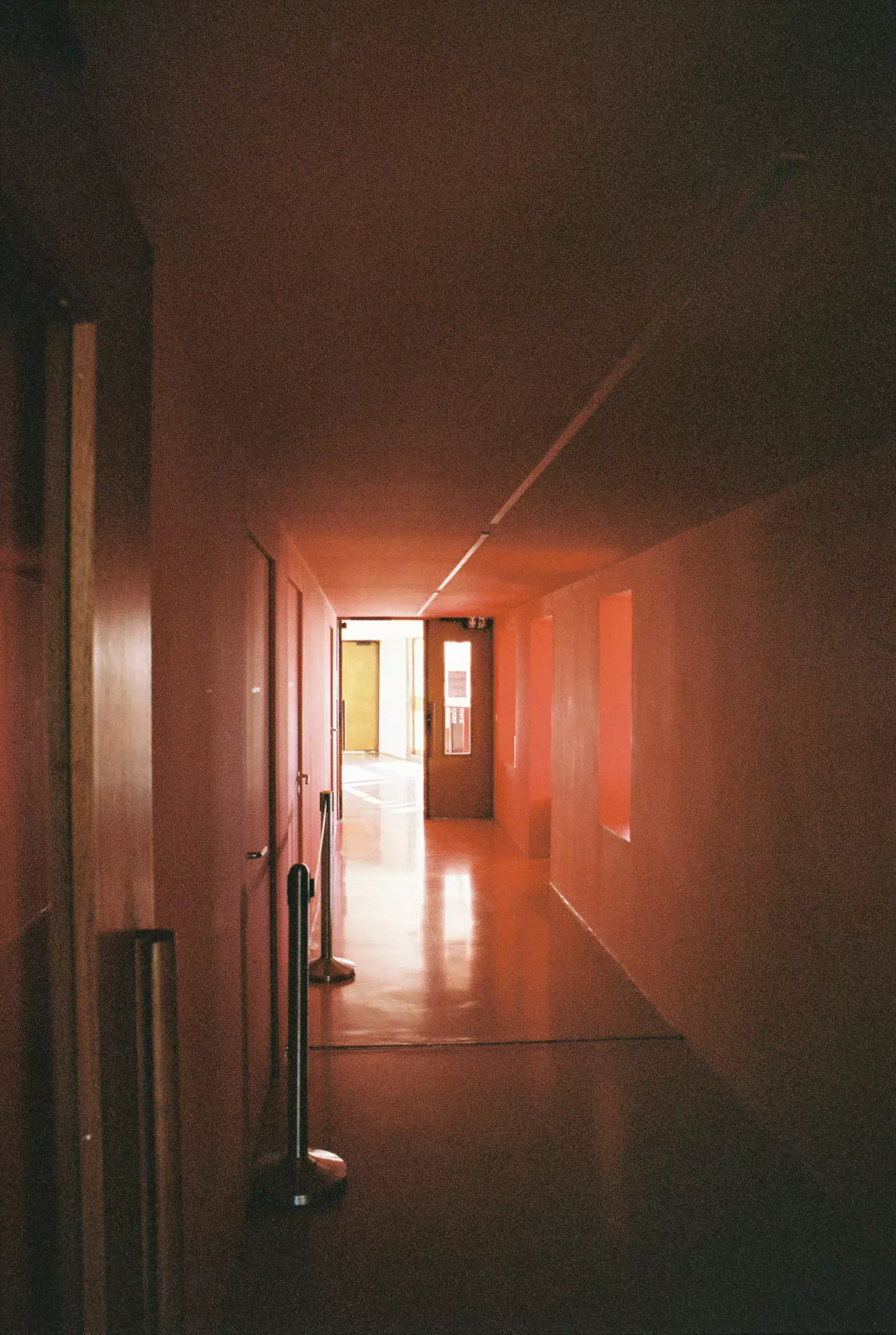

The choice of materials and colors used in Unité d’Habitation is in line with the principles of modernist architecture. Industrial materials such as concrete and glass support the architectural form and function.
Functionality and Ergonomics
Le Corbusier attached great importance to functionality and ergonomics in the interior design of Unité d’Habitation. The housing units are organized in accordance with the living needs of the users. In each unit, all the functions needed are provided in an easily accessible arrangement.
In addition, the furniture and furnishings in the interiors are designed to ensure the comfort and convenience of the users. Seating groups, dining tables, workspaces and storage areas provide a balance between practical use and aesthetic value.
Aesthetic and Visual Elements
Aesthetic and visual elements are also taken into consideration in the interior design of Unité d’Habitation. The harmony of colors, the correct use of lighting and artistic details complement the architectural arrangements.
Le Corbusier’s attention to detail in the interiors led to the design of the housing units in a simple and minimalist style. Clean lines, simple forms and solid colors reflect the basic principles of modernist architecture.
Unité d’Habitation has an important place in architectural history with its modernist architecture and interior design. Le Corbusier’s innovative approach and aesthetic approach distinguish this building from other similar projects. The interiors of Unité d’Habitation offer a functional, aesthetic and user-friendly experience in accordance with modernist architecture.
Unité d’Habitation and Postmodernism
Unité d’Habitation is a series of housing unit complexes designed by the modernist architect Le Corbusier. With its simple and functional design, this architectural work has had a major impact on modern architecture. However, Unité d’Habitation is also recognized as one of the pioneers of postmodernism.
While Le Corbusier’s modernist architectural approach emphasized functionality and simplicity, postmodernism offers an approach that questions and challenges these principles. Postmodernism takes a critical view of modernist architecture and emphasizes diversity, texture, quotation and irony in architectural design.
In the design of Unité d’Habitation, we can see a combination of modernist architectural principles and postmodernist elements. While Le Corbusier adheres to modernism with its concrete structures and functionality, the shape of the complex reflects postmodernist influences with its ornamentation and interior design.
Unité d’Habitation is seen in modernist architecture as a way to achieve a balance between home and society, while postmodernism questions this balance.
Unité d’Habitation’s relationship with postmodernism offers a perspective that opens up the understanding of modern architecture to re-evaluation and debate. Le Corbusier’s design has become the focus of architectural debates while maintaining the principles of modernist architecture.
By both referring to modernist architecture and reflecting postmodernist elements, Unité d’Habitation can be considered both an innovation and a challenge. This architectural work allows us to question and reflect on the world we live in and the way we view architecture.
Influences of Unité d’Habitation
Unité d’Habitation has had a profound influence on modernist architecture and concrete structures. Le Corbusier’s design offered a new perspective in the world of architecture and accelerated the development of modern architecture.
With the use of concrete structures and the evolution of modern architecture, the Unité d’Habitation has become an exemplary building. This work of architecture has had an inspiring influence on other architects and buildings.
“Unité d’Habitation’s innovative design approach to modern architecture and the use of concrete structures is a landmark in the field of architecture. This work of architecture is a great source of inspiration for architects.”
Concrete structures are considered a durable and sustainable building material. With the influence of the Unité d’Habitation, the popularity of concrete structures in modern architecture increased and many architects started working with this material.
In addition, the overall design of Unité d’Habitation and its innovative approach to housing units has had an inspiring impact on the field of architecture. Similar concepts and design approaches have been seen in other projects, demonstrating the influence of Unité d’Habitation on modern architecture.
World Famous Concrete Structures
| Structure | Location | Year |
|---|---|---|
| Burj Khalifa | Dubai, United Arab Emirates | 2010 |
| Millau Viaduct | France | 2004 |
| Sydney Opera | Sydney, Australia | 1973 |
| Pantheon | Rome, Italy | 126 AD |
Inspired by these buildings, architects have been able to reflect the influence of the Unité d’Habitation on modernist architecture in different ways. The durability, flexibility and aesthetic properties of concrete enabled the successful construction of these buildings.
Unité d’Habitation and Social Housing Projects
Unité d’Habitation brought a new perspective to the concept of social housing with Le Corbusier’s mass housing projects. Le Corbusier is recognized as an architect who offered innovative solutions to the housing problem.
The Importance of Social Housing
Social housing is a project designed to solve the housing problem and provide suitable housing for low-income or disadvantaged groups. These projects are developed to promote social justice and improve people’s quality of life. Social housing aims to provide a safe and healthy living space for those in need by offering high quality housing units at affordable prices.
“Public housing projects are crucial for achieving social balance and providing decent housing for disadvantaged groups. Unité d’Habitation has been a turning point in this regard.”
Impact of Unité d’Habitation on Social Housing Projects
Unité d’Habitation stands out as the first architectural structure to offer a social and functional approach to public housing projects. In this project, multiple housing units and social facilities coexist. Le Corbusier placed great emphasis on communal spaces to encourage social interaction and community integration. These spaces provide residents with places where they can come together and interact, strengthen their social relationships and develop a sense of community.



Importance of Social Housing Projects
Social housing projects are of great importance for improving the general welfare of society and ensuring social justice. These projects contribute to maintaining social balance and ensuring equal opportunities by providing suitable housing opportunities for low-income or disadvantaged groups. In addition, social housing projects provide a balanced planning approach to urban development, improving the sustainability and livability of cities.
| Public Housing Project | Architect | Year of Production |
|---|---|---|
| Unité d’Habitation | Le Corbusier | 1947-1952 |
| Robin Hood Gardens | Alison and Peter Smithson | 1972 |
| Red Road Estate | Sam Bunton, Peter Hamilton, Neil Munro, Andrew Whalley | 1964-1969 |
Importance and Evaluation of Unité d’Habitation
The Unité d’Habitation is a major landmark in terms of its importance and value in architectural history. Le Corbusier’s design contributed greatly to the development and evolution of the modernist architectural movement.
The Unité d’Habitation was constructed as a housing unit that adopted modernist architectural principles. The impact and value of this building in architectural history is not only related to its aesthetics, but also to the innovative approaches and functionality used in its design.
The Unité d’Habitation design has left a great legacy in architectural history. Reflecting Le Corbusier’s modernist architectural approach, this building has been a source of inspiration for future generations.
Unité d’Habitation is seen as one of the most important examples of the modernist architectural movement. It is recognized as one of the pioneers of modern architecture with its concrete structures, functional usage areas and original design.
Unité d’Habitation’s Contributions to Modernist Architecture
Unité d’Habitation was a turning point in the development of modernist architecture. The principles used in its design, such as concrete structures, functionality and focus on the needs of the user, brought a new perspective to modern architecture.
In addition, the Unité d’Habitation had a great influence on other modernist architectural buildings. The innovations and original approaches in its design have inspired architects and designers.
| Importance and Evaluation of Unité d’Habitation | Contributions to Modernist Architecture |
|---|---|
| Unité d’Habitation has left an important legacy in architectural history. | Concrete structures brought principles such as functionality and focus on the needs of the user to modern architecture. |
| Le Corbusier’s design contributed greatly to the development and evolution of the modernist architectural movement. | Unité d’Habitation has had a significant influence on other modernist architectural buildings. |
Unité d’Habitation and Sustainability
This section provides information about Unité d’Habitation’s approach to sustainable architecture and its low energy consumption and environmental awareness. Le Corbusier’s design has played a pioneering role in terms of energy efficiency and environmental sustainability.
Unité d’Habitation stands out as an example of modernist architecture and minimizes its environmental impact by adopting the principles of sustainable architecture. Its design is designed to provide energy efficiency and low energy consumption is targeted in the housing units. It also offers comfortable living spaces with natural ventilation.
The choice of materials used in the design of Unité d’Habitation is in harmony with the idea of environmental sustainability. Concrete was chosen for its durability and low maintenance requirements. The use of recycled materials in the construction of the project also emphasizes environmental sustainability.
Unité d’Habitation’s understanding of sustainability has contributed to the development of modern architecture as sensitive to environmental impacts. The pioneering nature of its design has also inspired other architects and projects. Built with the principle of sustainability in mind, this housing unit is still today exemplified as a sensitive approach to environmental impact.
Restoration of the Unité d’Habitation
The Unité d’Habitation is considered one of the most important examples of modernist architecture. Le Corbusier’s unique design may have been worn out or damaged over time. Therefore, the restoration and renovation of the building is of great importance.
Many restoration experts and architects believe that the original design and aesthetics of the Unité d’Habitation should be preserved. Therefore, the restoration process of the building must be meticulously planned and implemented.
The restoration process includes the rehabilitation of the concrete elements that make up the structure. Cracks and damage to the concrete elements should be repaired and, if necessary, the concrete should be reinforced again. Restoration work emphasizes the use of original materials and preserving the integrity of the design.
It is also important to renovate the interiors during the restoration process. The Unité d’Habitation’s characteristic interiors can be restored and recreated in their original form through restoration work.
Challenges in the Restoration of the Unité d’Habitation
The restoration of a building is always a process full of challenges and problems. The restoration of the Unité d’Habitation was not without its challenges.
- The restoration of concrete elements in accordance with the original structure requires special expertise and attention.
- It is important that the changes made during the restoration process are in line with the original design and do not spoil the aesthetics of the building.
- The interiors of the building should be faithful to the original design and at the same time be adapted to modern comforts.
Unité d’Habitation’ın Restorasyonu ve Modernist Mimari
The restoration of the Unité d’Habitation is of great importance for the preservation and transmission of modernist architecture to future generations. These restoration works ensure the preservation of the architectural heritage and emphasize the value of modernist architecture.
| Benefits of Restoration | Challenges of Restoration |
|---|---|
| Preserving the original design and aesthetics Increasing the durability of the building Respecting the value of the past | Costs incurred Finding original materials Finding skilled workers suitable for the period of the construction |
The restoration of the Unité d’Habitation shows respect for modernist architecture and the legacy of Le Corbusier. These works emphasize the value and importance of modernist architecture by passing the building on to future generations.
Unité d’Habitation and Urban Planning
Unité d’Habitation plays an important role in urban planning. Together with the innovations brought by Le Corbusier to modern architecture, it sets an important example in the modernization process of cities. With its design, it offers an innovative solution to urban texture and housing needs.
Le Corbusier was an architect who offered important suggestions on the planning of cities. With his Unité d’Habitation design, he aimed to ensure the orderly and balanced development of cities by bringing housing together in terms of height and density. This approach also makes an important contribution to the creation of quality living spaces and social areas.
Le Corbusier’s Approach to City Planning
Le Corbusier is one of the leading representatives of modern architecture and has left a great impact on architectural history with his proposals on urban planning. He offered geometric and functional solutions to solve the complexity of cities and the housing problem.
Le Corbusier: “Cities need light, air and green spaces. Fluidity, functionality and an aesthetic approach are the cornerstones of livable cities.”
In Le Corbusier’s designs, it is an important principle to consider urban planning and architecture as a whole. In his housing unit designs, while creating living spaces that meet the needs of people, he also considers the aesthetic value of cities.
Impact of Unité d’Habitation on City Planning
Unité d’Habitation has had a significant impact on urban planning. Its design offers the possibility to efficiently utilize the limited space of cities by combining housing in a vertical arrangement. In addition, the design’s emphasis on social spaces and green areas contributes to the creation of a livable environment for the inhabitants of cities.
Le Corbusier’s proposals and Unité d’Habitation design contain many principles that are still considered and inspiring today in urban planning. Le Corbusier’s approach and design is considered as an important reference in the process of modernizing cities and making them livable.


Unité d’Habitation and Cultural Heritage
Unité d’Habitation, one of the most important works of modernist architecture, is of great importance not only in terms of architecture but also in terms of cultural heritage. Le Corbusier’s iconic design is a building worth preserving its place in architectural history and cultural value.
Unité d’Habitation is considered one of the most important examples of modernist architecture. This architectural marvel, which attracts attention with its concrete structures, is considered one of the turning points in the history of Architecture.
The Unité d’Habitation has become a symbol of modernist architecture. Le Corbusier’s design revolutionized the field of architecture and is still inspiring today.
Unité d’Habitation is a building that should be considered a cultural heritage. It emphasizes Le Corbusier’s contribution to modern architecture and the influence he had with this building.
An important part of the Unité d’Habitation’s cultural heritage is the universal value of Le Corbusier’s design. A landmark in the field of architecture, this building played a major role in the development of modern architecture.
Importance of the Unité d’Habitation for Cultural Heritage
In its architectural design, Unité d’Habitation stands out as an original example of modernist architecture. It is an important milestone in the history of architecture and a valuable building to preserve its cultural heritage.
The Unité d’Habitation reflects the basic principles of modernist architecture and retains its place in architectural history. It represents Le Corbusier’s important contribution to large public housing projects.
This architectural marvel keeps the interest in modernist architecture alive. The Unité d’Habitation’s cultural heritage status is of great importance for its preservation and transmission to future generations.
Le Corbusier and Cultural Heritage
Le Corbusier is one of the leading figures of modernist architecture. Known for his creative and innovative designs, Le Corbusier has made valuable contributions to architectural heritage with works such as Unité d’Habitation.
Le Corbusier’s architectural perspective is of great importance not only for design but also for cultural heritage. His works, such as Unité d’Habitation, are an important part of architectural history and are recognized worldwide.
| Unité d’Habitation and Cultural Heritage | Le Corbusier’s Legacy |
|---|---|
| Modernist mimari açısından önemli bir yapıdır | Revolutionary designs in the field of architecture |
| Part of the cultural heritage | It had a major impact on the field of architecture |
| Considered a building in need of protection | Their designs are recognized as architectural heritage |
Frequently Asked Questions
- What is Unité d’Habitation?
- Unité d’Habitation is a residential complex designed by the famous architect Le Corbusier. It is considered an important example of modern architecture and is notable for its open-plan layout and common areas that encourage social interaction.
- Where is Unité d’Habitation?
- Unité d’Habitation is located in Marseille, France. It was built in this large city in the south of France, on the Mediterranean coast.
- When was the Unité d’Habitation built?
- Unité d’Habitation was built between 1947 and 1952. It was built immediately after the Second World War to meet the need for housing in the post-war period.
- Who was Le Corbusier and why did he design the Unité d’Habitation?
- Le Corbusier was a famous Swiss-French architect and one of the leading figures of modern architecture. Buildings such as the Unité d’Habitation carried his vision of building dwellings where people could interact more comfortably and socially.
- What is the architectural style of Unité d’Habitation?
- Unité d’Habitation is an example of modernist and functionalist architectural style. It reflects the basic principles of modern architecture, such as the use of industrial materials, open plan layout and the importance of common areas.
- What types of housing are available in the Unité d’Habitation?
- Unité d’Habitation is a complex of different sizes and types of housing. The living units range from studio apartments to larger family residences.
- What are the common areas in Unité d’Habitation?
- The development offers its residents a variety of communal areas where they can spend time together. These include children’s playgrounds, sports facilities, relaxation and interaction areas.
- What facilities does Unité d’Habitation offer its residents?
- Unité d’Habitation offers its residents a modern lifestyle. It also encourages social interaction through communal spaces and activities.
- What is the cultural and historical significance of the Unité d’Habitation?
- Unité d’Habitation is an important symbol of the evolution of modern architecture and the legacy of Le Corbusier. It is also an expression of the effort to meet the housing needs of the post-war period.
- Is it possible to visit the Unité d’Habitation?
- Yes, the Unité d’Habitation is open to the public and can be visited. Visit this important building in Marseille and discover an important example of modern architecture.
My Thoughts on Unité d’Habitation
Unité d’Habitation is considered one of the most important works of modern architecture. Designed by Le Corbusier, this apartment complex functions not only as a residential building but also as a space for community living and social interaction.
Reflecting Le Corbusier’s functionalism and modernist approaches, Unité d’Habitation stands out with its use of industrial materials, open plan layout and the importance of common spaces. Beyond just a few architectural details, this complex represents an environment where people can live together, interact and socialize.
The architectural design of Unité d’Habitation, with its vertical gardens, open terraces and communal areas, reflects not only a residence, but also a way of life. Residents can interact with each other while enjoying the amenities of modern living.
Architecturally, Unité d’Habitation is not just a building, but a symbol of a space where people can come together and form a community. This complex is an important example of the evolution of modern architecture and how it shapes people’s living spaces.
If you haven’t read it yet, you can also check out our review Villa Savoye À Poissy – Future Past…
Architect: Le Corbusier
Architectural Style: Modernist, Functionalist
Year: 1947-1952
Location: Marseille, France
Discover more from Dök Architecture
Subscribe to get the latest posts sent to your email.



